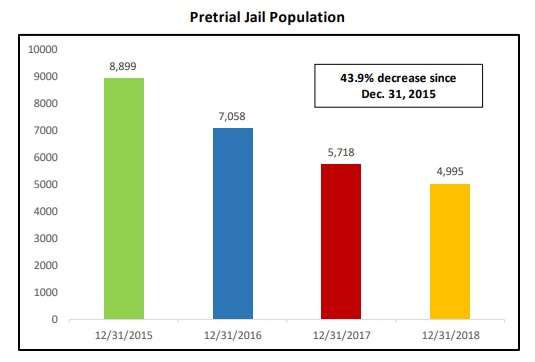New Jersey Is Keeping More and More People Out of Jail, and That's Great
New Jersey is detaining almost half as many people pretrial, and the state is not seeing a big crime wave.

When New Jersey stopped using cash bail and started letting more people out of jail before their trials, some skeptics worried about a crime increase. A new report shows the crime wave hasn't happened. That's great news.
For two years now, New Jersey has used a pretrial system that does not rely on cash bail to determine who is freed prior to their day in court and who is left in jail. Instead, the state has implemented a system that assesses each defendant's risks (of skipping out on court or committing new crimes) and then recommends monitoring and reporting guidelines for those who are released. If a prosecutor can make a case that a defendant is too dangerous to be released at all (because they'll skip out on court or cause new harms), the defendant is detained prior to trial.
On Tuesday, New Jersey Courts released a report analyzing data about its pretrial system for 2018, comparing it to previous data and what pretrial systems looked like before they switched to a mostly bail-free system. Here's some relevant numbers from the report:
- The number of people incarcerated in New Jersey has declined by 6,000 when comparing 2018 to 2012. Since 2015, New Jersey's standing pretrial jail population has dropped 43.9 percent, from 8,899 people to 4,995 people, measured on the last day of the year.

- Across all of 2018 the rate of pretrial detention for people charged with crimes was less than 7 percent, 8,669 out of 135,009 people charged. People who are charged with crimes are also spending less time in jail before being released, dropping from an average of 7.4 days to 3.7 days. The shift is more dramatically pronounced among black defendants (dropping from an average of 10.7 to five days), but affects all people.
- While there's been a dramatic drop in the number of people being detained, there has been a very small uptick in new criminal charges against defendants while on release (12.7 percent to 13.7 percent) and a small drop in the court appearance rate (92.7 percent to 89.4 percent).
- As part of these pretrial detention reforms, New Jersey put out new directives to law enforcement officers to get them to shift away from arresting defendants for low-level crimes and instead giving them a summons to appear in court. Between 2014 and 2018, there's been a 17 percentage point shift in favor of police giving out a summons order rather than making an arrest. So, fewer people are ending up in jail in the first place.
- The percentage of people who remain in jail being charged or sentenced for one or more violent offenses has increased from 35 to 47 percent. That doesn't mean there are a greater number of violent criminals; it means that a greater proportion of the people who remain behind bars are there for crimes deemed violent. Crime in New Jersey is down.
- While the total number of people incarcerated in New Jersey has dropped, a lot of the racial and ethnic makeup remains the same, meaning New Jersey is still jailing a disproportionately large number of black males (54 percent of the males in jail are black). It's different for women though: Black women dropped from 44 to 34 percent of the jail population, while white women increased from 44 to 54 percent between 2012 and 2018. Just to be abundantly clear here: They aren't arresting greater numbers of white women. As arrests overall are dropping, the demographics of jailed women are more closely matching New Jersey's actual racial makeup.
- The assessment tools New Jersey courts have been using to create a risk score seem to be pretty accurate. New Jersey's system uses two numbered scales that—based on the defendants' own criminal history—put scores on how likely they are to skip out on court or commit additional crimes while freed. The data shows that 9.7 percent of the defendants given a low score of "1" committed an indictable offense after being released. But those who ranked the highest on the scale—given a "6"—had a re-offense rate of 61.6 percent after release.
The success of the assessment system is absolutely vital to getting other states to follow in New Jersey's footsteps. Criminal justice reform and civil rights groups are deeply concerned that the thoughtless application of vague assessment systems and algorithm-based scores could repeat the problems of cash bail—that poor defendants in communities targeted by police for enforcement will be treated as higher risk and end up detained yet again. Meanwhile, judges are worried that they'll be held politically accountable if they release somebody with no bail requirement and they go on to commit an even more serious crime.
New Jersey's assessment system has a few things going for it in both respects. First, the defendants are scored based on their own histories, not any demographic or community data. If they've previously been convicted of crimes or have previously missed court dates, that's what affects their scores, not their employment status or median household income or crime rates where they live. And while the assessment system is computerized, it produces a detailed summary of what contributed to the scores that human beings get to consult—including judges and attorneys on both sides.
Second, the assessment scores are recommendations, not the final determinant of whether a person will be detained. If a prosecutor thinks a defendant is too dangerous to be released, he or she has to make the case before a judge at a hearing with a defense attorney there to represent the other side.
The use of those additional steps, rather than just relying on a bail schedule and making the bail bondsmen responsible for tracking defendants, does lead to another problem: funding. This entire pretrial system—including pretrial monitoring of defendants—costs money that hasn't been properly budgeted by the state. It's being funded right now with revenue coming from filing fees, but the report notes that it's not enough to cover future expenses. Since the program's launch, the state's pretrial service programs have spent $61.8 million of the $88 million they've been granted from the revenue from filing fees. They predict annual deficits within a fiscal year and want these pretrial services to be funded directly from the state budget.
The American Civil Liberties Union in New Jersey agrees that they'd like to see pretrial services fully funded from the state's budget. In a prepared statement, New Jersey ACLU Senior Supervising Attorney Alexander Shalom notes:
This report makes abundantly clear that criminal justice reform does not make New Jersey any less safe than it was prior to the law's enactment, and those charged with a crime are no less likely to appear in court than they previously were.
What's more, thousands of low-risk defendants are now being diverted from the jail intake process altogether, instead receiving summonses that minimally disrupt their lives while the accusations against them are adjudicated. That's a clear victory for civil rights, and a benefit of reform that hasn't been talked about enough.
We applaud the [Administration office of the Court]'s work in compiling comparative pre- and post-legislation data regarding race and ethnicity and appreciate its commitment to continue addressing racial disparities. A system that reduces the number of incarcerated people but does not improve racial disparities is simply not good enough. We intend to continue our advocacy efforts to reduce racial disparities in the criminal justice system and to advance justice.
Read through the New Jersey pretrial report for 2018 here. And for an inside look at how New Jersey's pretrial systems operate, check out Reason's cover story on bail reform from August/September 2018.

Show Comments (15)